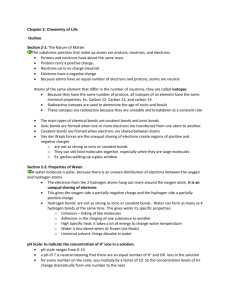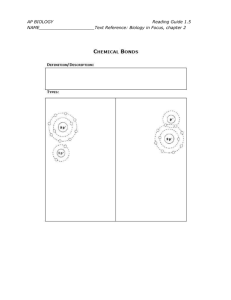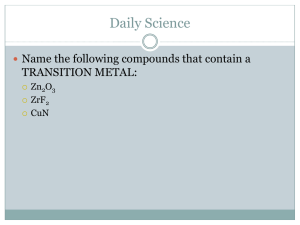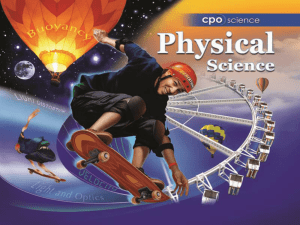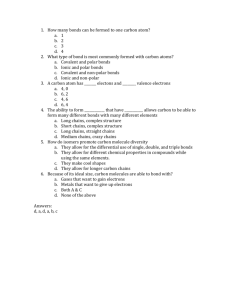Instructor: Mr - The Powers That Be
advertisement
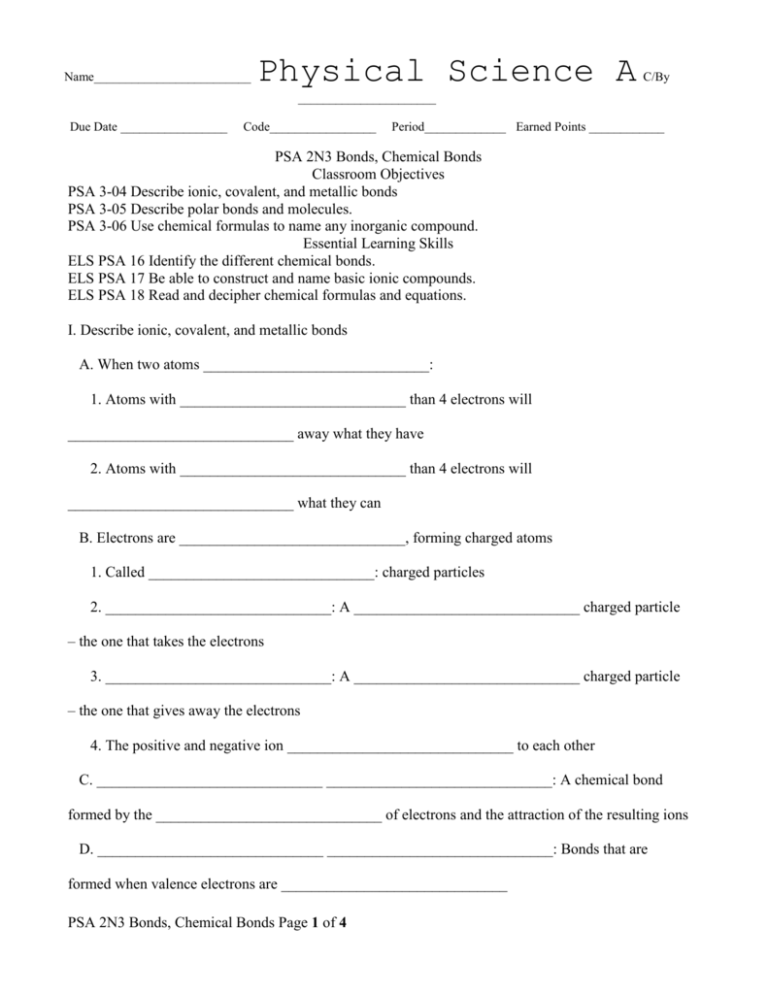
Name_________________________ Physical Science A C/By ______________________ Due Date _________________ Code_________________ Period_____________ Earned Points ____________ PSA 2N3 Bonds, Chemical Bonds Classroom Objectives PSA 3-04 Describe ionic, covalent, and metallic bonds PSA 3-05 Describe polar bonds and molecules. PSA 3-06 Use chemical formulas to name any inorganic compound. Essential Learning Skills ELS PSA 16 Identify the different chemical bonds. ELS PSA 17 Be able to construct and name basic ionic compounds. ELS PSA 18 Read and decipher chemical formulas and equations. I. Describe ionic, covalent, and metallic bonds A. When two atoms ______________________________: 1. Atoms with ______________________________ than 4 electrons will ______________________________ away what they have 2. Atoms with ______________________________ than 4 electrons will ______________________________ what they can B. Electrons are ______________________________, forming charged atoms 1. Called ______________________________: charged particles 2. ______________________________: A ______________________________ charged particle – the one that takes the electrons 3. ______________________________: A ______________________________ charged particle – the one that gives away the electrons 4. The positive and negative ion ______________________________ to each other C. ______________________________ ______________________________: A chemical bond formed by the ______________________________ of electrons and the attraction of the resulting ions D. ______________________________ ______________________________: Bonds that are formed when valence electrons are ______________________________ PSA 2N3 Bonds, Chemical Bonds Page 1 of 4 1. When the atoms ______________________________, the electron stays with the ______________________________ atom 2. No ______________________________ are formed 3. This “______________________________” the atoms into “______________________________” the orbital are full. 4. The electron goes around ______________________________ nuclei E. ______________________________ ______________________________: Covalent bonds between ______________________________ ______________________________ of metals atoms 1. Electrons are ______________________________ not between two atoms, like a covalent bond 2. But between ______________________________ the atoms like a ______________________________ bond 3. The ______________________________ atoms form ______________________________: Positively charged ions 4. They are ______________________________ by a “sea” of electrons (-) 5. Overall, the metal has ______________________________ II. Describe polar bonds and molecules. A. Electrons are not always shared ______________________________ due to 1. ______________________________ of the atom 2. ______________________________ of the nucleus 3. ______________________________ number of electrons B. One side is ______________________________ negative C. The other is ______________________________ D. ______________________________ ______________________________: A covalent bond in which electrons are ______________________________ shared equally PSA 2N3 Bonds, Chemical Bonds Page 2 of 4 E. ______________________________ ______________________________: A molecule with polar bonds that is unbalanced F. ______________________________ ______________________________: A molecule in which electrons are shared equally or polar bonds are balanced III. Use chemical formulas to name any inorganic compound. A. Use the ______________________________ numbers to identify how many of the ______________________________ ion will attach. B. ______________________________ charge must = ______________________________ C. “______________________________” method 1. Write down the ______________________________ 2. Identify the ______________________________ numbers 3. ______________________________! 4. Make it the ______________________________ ratio 5. By agreement the ______________________________ always goes ______________________________. 6. The ______________________________ ion is always identified not as the element but as the ______________________________ (ends in –ide) 5. Examples D. Naming covalent compounds 1. Most are named the ______________________________ way as ionic, pretending that the ______________________________ is an ion PSA 2N3 Bonds, Chemical Bonds Page 3 of 4 2. ______________________________ are named based on a system ______________________________ in use (carbon dioxide, water, etc.) PSA 2N3 Bonds, Chemical Bonds Page 4 of 4

